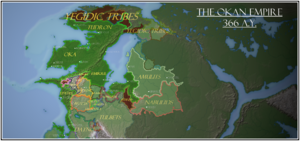Dotruga

| Republic of Dotruga | |
|---|---|
| Template:Infobox country/imagetable | |
| Capital | Naskitrusk |
| Population | |
• Census | Population::213,409,106 |
| ISO 3166 code | [[ISO 3166-2:Template:ISO 3166 code|Template:ISO 3166 code]] |
The Commonwealth of Dotruga is a nation located off the northwestern coast of Continent::Delezia in the region of Amaio. Comprising the nations of Okanaio, Tutono, and Enriujim, Dotruga is the second most populous and second largest country in Amaio. Its capital city is Naskitrusk, while its largest city is Stedro. The Dotrugan region has a long and storied history, dating back to the migration of Proto-Ipaloit tribes to the area over 20,000 Y ago. The first major civilization to emerge in the region was the Okan Confederacy, which eventually grew into an empire that covered vast parts of Amaio around 6750 Y. Following the dissolution of the Okan Empire around 7100 Y, the region experienced a period of fragmentation and division, with various smaller kingdoms and states vying for power and influence. It wasn't until the formation of the first Republic of Dotruga in 9600 Y that the region was once again united under a single banner. Since then, Dotruga has undergone significant political and social changes, culminating in the establishment of the Commonwealth of Dotruga in 9830 Y.
Etymology
The name "Dotruga" has its origins in the ancient Okan language, which was spoken by the indigenous people of western Amaio. The word "Dotruga" is derived from the Old Okan words, "Doti" and "Ulrug". "Doti" means "land" or "territory", while "Ulrug" means "united" or "unified". Therefore, "Dotruga" can be roughly translated to mean "unified land" or "united territory". The name has a long history that dates back to the early days of the Okan Empire. When the Okan Empire was first established, it encompassed a large portion of western Amaio, including what is now Dotruga. Over time, the people of the region came to refer to the area as Dotruga, signifying the unity of the land and its people. As the Okan Empire declined and eventually fell, the region of Dotruga remained relatively stable, with various kingdoms and city-states emerging and vying for power. However, the name Dotruga continued to be used to refer to the region as a whole.
History
Early History
The early history of Dotruga is shrouded in mystery and legend, with little concrete information about the earliest inhabitants of the region. Archaeological evidence suggests that various tribes, such as the Okans, the Votari, and the Kondans, lived in the area long before the formation of the first notable civilizations.
Around 4800 Y, the first city-states began to emerge in Dotruga, centered around the fertile river valleys of the region. These early cities, such as Aradun and Valtari, were primarily agricultural in nature and relied heavily on trade with neighboring regions to supplement their resources. As these city-states grew in power and influence, they began to develop their own distinct cultures and political systems. The Aradunian city-state, for example, was known for its highly organized military and efficient bureaucracy, while the Valtarian city-state was renowned for its artistic and intellectual achievements.
Okan Dynasty
The Okan Confederacy was formed in the region that is now known as Dotruga around 6300 Y on the Meta calendar. It was a union of several tribes that inhabited the area, including the Okans, the Galdis, and the Jirakans. Akanis Vangfelir, the founder of the Okan Confederacy, is a prominent figure in the early history of Dotruga. His rise to power and establishment of the Confederacy under one emblem, or 'Uneka', marked a significant turning point in the political landscape of the region. Born into a prominent family, Akanis was known for his military prowess and strategic thinking. He gained fame as a successful general in various tribal conflicts, eventually earning the respect and loyalty of many warriors across the region. As he gained more followers, he began to envision a unified Dotrugan society, free from the constant invasions that plagued the region.
In his quest for unification, Akanis sought to establish a Confederacy under one Uneka, a symbolic emblem that represented the unity and strength of the confederated tribes. After much negotiation and persuasion, he was able to convince the leaders of various tribes to pledge their allegiance to the Okan emblem and join the Confederacy. Akanis Vangfelir was chosen as the first leader, or Unevan, of the Confederacy, and his authority was recognized by all the tribes.
The establishment of the Okan Confederacy under one Uneka brought about a period of relative peace and stability in the region. Akanis Vangfelir's military expertise and political acumen allowed him to maintain unity among the tribes and fend off external threats. He also introduced reforms that promoted cultural and economic exchange between the tribes, leading to greater social cohesion and prosperity.
The Okan tribe was the most dominant of the confederacy, and eventually, under Narogakur the Great, succeeded in unifying the confederacy and forming the Okan Empire around 6750 Y. Under Narogakur the Great, the Okan Empire rapidly expanded its territory, conquering neighboring tribes and forming alliances with others. The empire was a technologically advanced society, with impressive infrastructure, such as a vast network of roads and canals, which greatly aided trade and commerce. Narogakur the Great was also a patron of the arts and sciences, and the empire became known for its advances in mathematics, astronomy, and architecture.

The Okan Empire went through several dynasties, each marked by periods of relative stability and prosperity. However, there were also times of turmoil and conflict. One of the most significant wars in the history of the empire was the Okan-Uluwizhan War, which began in 6810 Y. The Okan Empire, at the time, was engaged in a struggle for power with the neighboring Empire of Uluwizha. The war lasted for nearly 20 Y, and while the Okan Empire emerged victorious, it was left weakened by the conflict. Despite this setback, the Okan Empire continued to thrive, and during the 6900s Y, it experienced a golden age of cultural and technological advancement. During this time, the empire produced some of its most famous scholars, poets, and architects, and the construction of monumental buildings, such as the Great Mondra-Vah Palace and the Temple of the Moon, began.
However, the Okan Empire began to decline in the early 7000s Y due to various internal and external factors. The empire became plagued by corruption and economic stagnation, and its armies were increasingly challenged by invading forces. The Okan Empire eventually collapsed in 7100 Y, marking the end of the Okan Dynasty and the beginning of a new era in Dotrugan history. Despite its eventual decline and fall, the Okan Empire left a lasting legacy in Dotruga. Its technological and cultural achievements continued to influence the region for centuries after its collapse, and the memory of the Okan Dynasty remained a source of inspiration for many Dotrugans. Today, the ruins of the Mondra-Vah Palace and other structures serve as a reminder of the power and grandeur of the Okan Empire.
Dark Ages
Era of Two Giants
Industrial Era
Modern Era
Geography
Climate
Topography
Government and Politics
Government
Dotruga is governed by a unique system that centers around three chiefs: The Chief of State, The Chief General, and the Chief Ambassador. These chiefs are elected by the Grand Electoral Body every 6 years, with a limit of two consecutive terms. The Grand Electoral Body, in turn, is composed of government officials who are elected directly by the voting population every 12 years, and have the ability to hold their position for life, so long as they continue to be elected by the population.
- The Chief of State is responsible for the overall administration and governance of the country, including managing the budget, overseeing the civil service, and executing laws and regulations. This chief serves as the ceremonial head of state and occasionally represents the country in international affairs.
- The Chief General is responsible for the defense of the country and oversees the military and security forces. This chief holds significant power over the armed forces, and decisions regarding the deployment and use of military force must be approved by them.
- The Chief Ambassador is responsible for the country's foreign policy and relations with other nations. This chief negotiates treaties and agreements with other countries and represents Dotruga in international organizations.
This system of government aims to balance the power among the three chiefs, preventing any one individual from becoming too powerful. It also ensures that the population has a say in the government through the direct election of the Grand Electoral Body.
In international exchanges, the Chief Ambassador represents Dotruga as the country's primary diplomatic representative. The Chief of State and the Chief General may be present in certain diplomatic meetings and negotiations depending on the subject matter and the level of importance to the country's foreign policy objectives. However, the Chief Ambassador typically serves as the lead representative in such exchanges, as they have specialized training and expertise in international diplomacy and relations.
Economy
Culture
Music
Visual Art
Symbols
Cuisine
Sports
Demographics
Ethnicities
Language
Religion

Data
Continent - Continent::Delezia